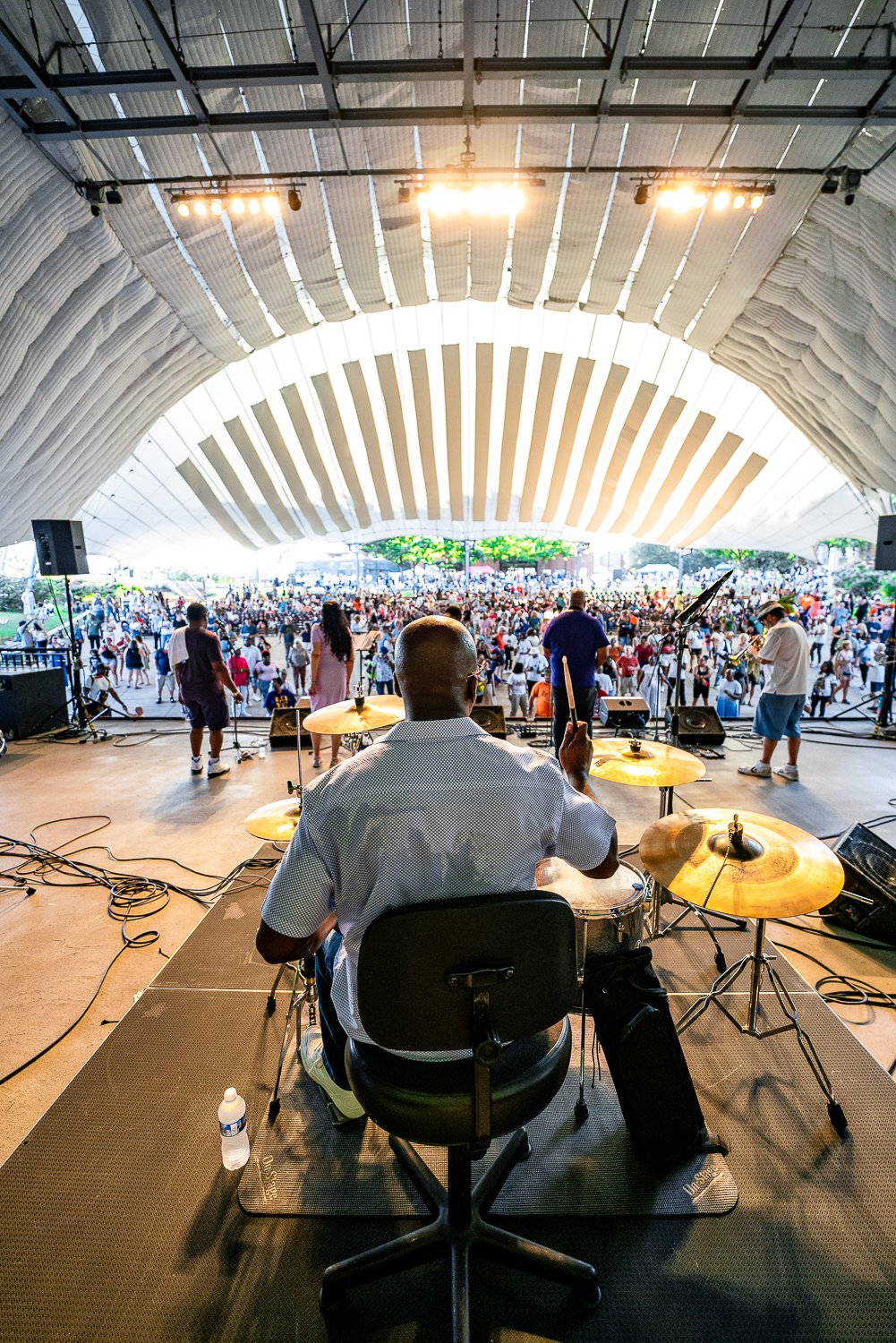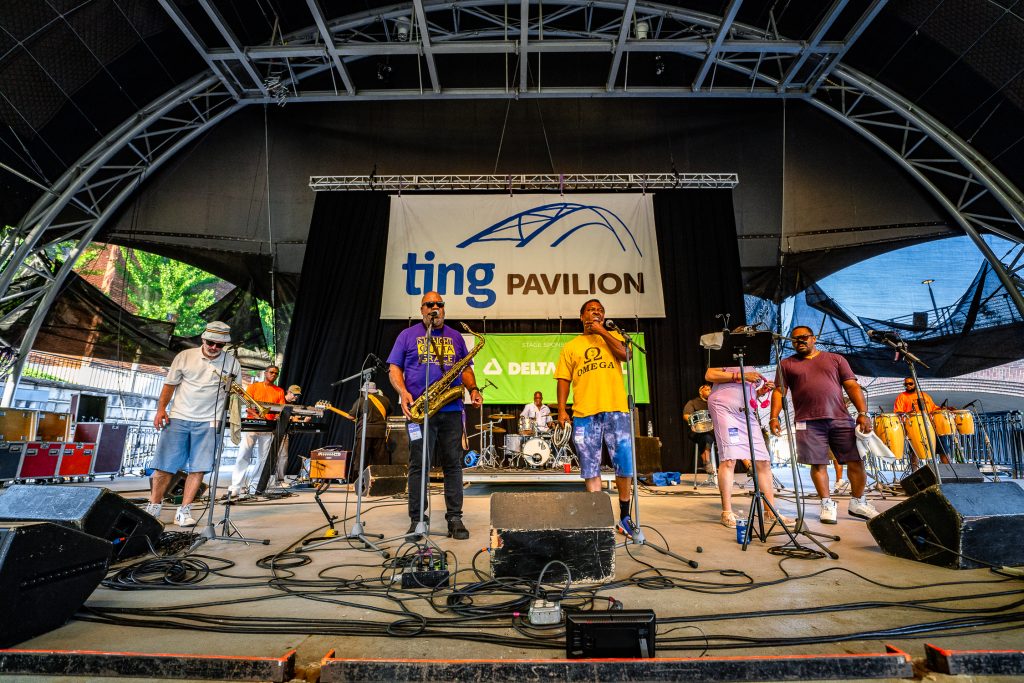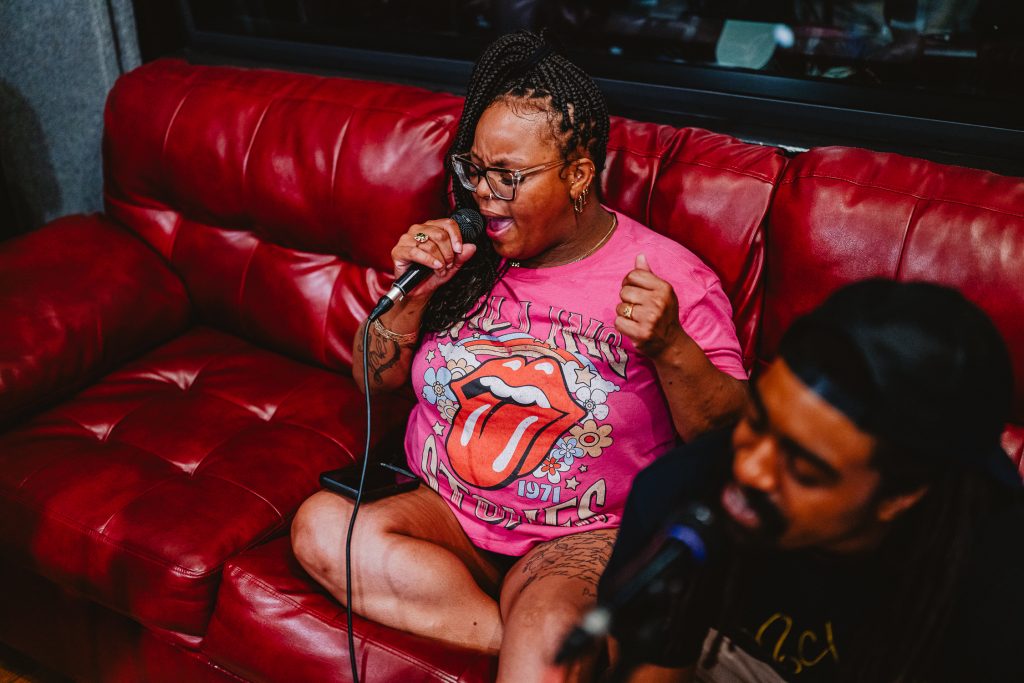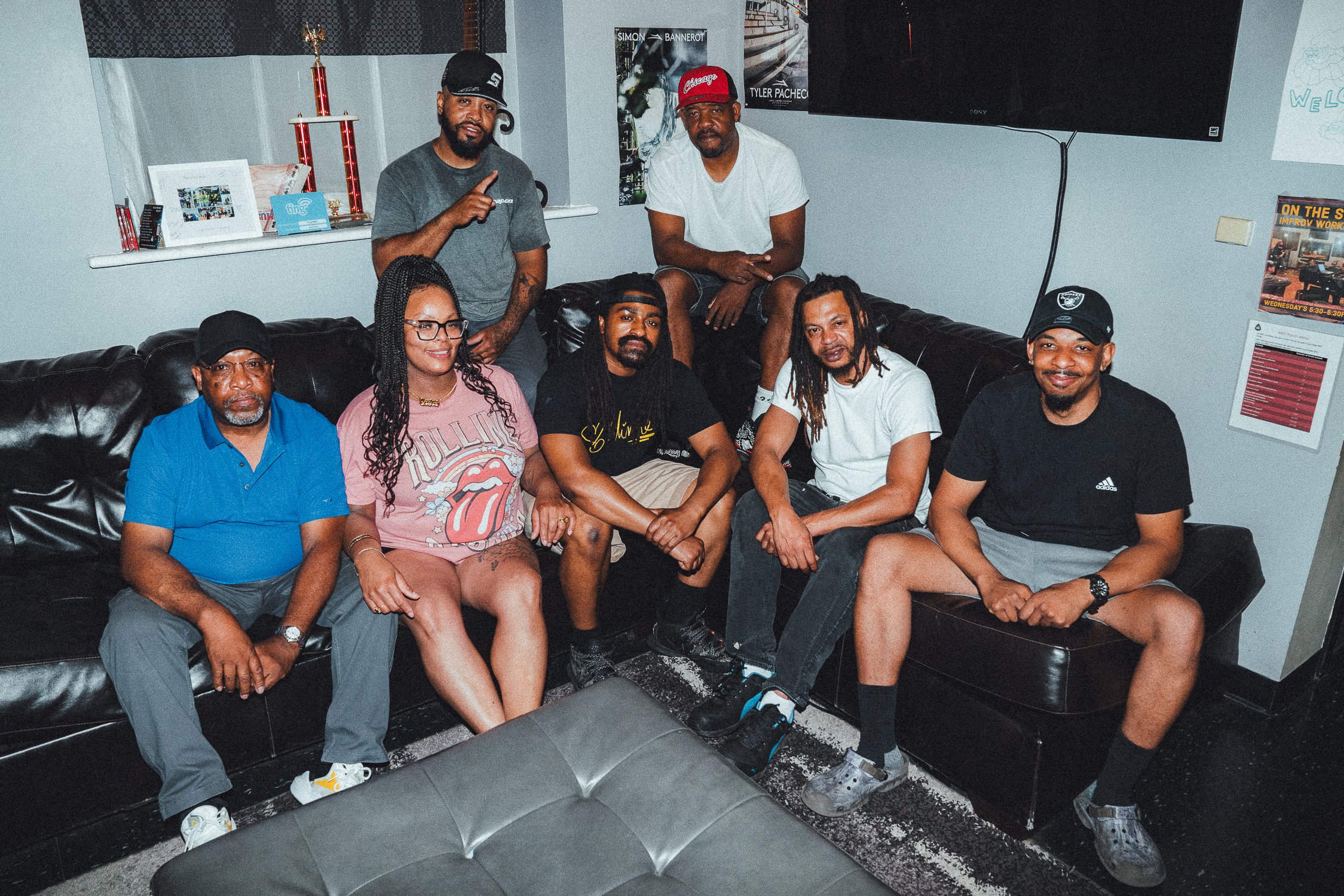We Can Show You Better Than We Can Tell You


Disclaimer: This narrative is not the complete history of Gogo music in Charlottesville. This article serves as an in-depth look at the perspectives of Gogo music enthusiasts and community members who have contributed to its evolution and presence in Charlottesville. It aims to highlight their experiences, insights, and contributions to the vibrant and growing Gogo music scene within the city.
Gogo, the offspring of funk and soul music, originated in Washington, D.C. in the 1970s. Innovators like Chuck Brown, widely respected as the ‘Godfather of Gogo,’ paved the way for the music genre. Heavily influenced by African culture and characterized by its use of congas and timbale drums, which set the percussive tone of the sound, Gogo has become a cultural staple in the states of D.C., Maryland, and Virginia, also known as the DMV area.
Comical debate on the internet has displayed the divided opinion amongst residents of the National Capital Region on what areas of Virginia are considered a part of the [V] within the DMV. Depending on who you ask, the delineation between what constitutes the broader state of Virginia, and the core DMV area can vary. Places like Charlottesville and its surrounding rural counties are often overlooked as they tend to differ in culture and distance from the bustling artistic influence of the DMV. However, Charlottesville’s long-standing Gogo bands, Ebony Groove and 100 Proof, beg to differ. Both bands recently sat down with Vinegar Hill Magazine to share just what they mean.
As the decades of the 1970s and 1980s progressed, Gogo music flourished with bands such as Rare Essence, Backyard Band, EU, and many others, carrying forward Chuck Brown’s legacy and gaining momentum as it expanded its reach. Ivan Orr states, “It’s like, I don’t remember a time where there wasn’t Gogo around [in Charlottesville].” Orr, a group member of Charlottesville’s pioneer Gogo band, Ebony Groove, took to the strong influence that Gogo’s hard-hitting ongoing percussion and traditionally rooted call-and-response music had to offer. Ebony Groove is recognized by city residents as this area’s first homegrown Gogo band, and its founding members Kyle Reaves, Christopher Redd, Ivan Orr, Curtis Kenney, Jesse Turner, and Raymond Brooks met at Charlottesville High School in the marching band.With Jesse Turner and Chris Redd playing trumpet, Ivan Orr on saxaphone, while Raymond, Kyle and Curtis were members of the drumline. A predominantly white high school around 1984, Ebony Groove members recall being some of the only Black members of a band with over 200 students. “Oh yeah. When we started, we were the first drum line [in the city] to play Gogo at halftime,” shares Curtis Kenney. Their impromptu performance next to the cheerleaders in the stands catalyzed the band’ to take their craft more seriously, and thought they officially formed in 1987, their drumline performance created fans that have followed them throughout their musical careers. Kenney states, “[Before], you sat in the stands and played and be quiet. But we, uh, got them to break the mold, didn’t we?”
While it is unclear just how Gogo entered Charlottesville’s mountainous town of 40,000 plus citizens, there are a few factors that have contributed to its spread and integration. The presence of the University of Virginia and Howard University, where students from both cities exchanged cultural influences, played a significant role. Jeff Louderback Sr. and Billy Wells of 100 Proof band recall vivid memories of Chuck Brown performing at UVA when they were younger, while members of Ebony Groove were introduced to early funk and Gogo albums like Trouble Funk, by family members who attended Howard University or lived in Washington, D.C. in general. “My sister lived in D.C. while we were in high school, and I would go to visit, but I mean, if you think back before that, though, like when we were kids, Gogo was here. I think all of us could say we had relatives there. So, they would come, you know, for visits, or we’d go and hear the music,” says Ebony Groove bandmate Raymond Brooks. This exposure fueled their passion and inspired them to master the music.
James Cain, a Howard University alum, and son of Charlottesville’s first Black woman lawyer, Margaret Cain, considers Charlottesville and D.C. the Pompeii and Rome of our time. Respected by Charlottesville Gogo enthusiasts for his historical insight, Cain sees strong parallels between the two cities. He explains that much like Pompeii looked to Rome for political and economic influence, Charlottesville aligned with D.C. from the 1970s to the 1990s, shaping its Gogo sound. Ebony Groove shares similar sentiments as they state that cultural cues for Charlottesville in their upbringing did not come from Virginia’s capital of Richmond, but rather from Washington, D.C. Ivan Orr states, “And what’s wild is, y’all can correct me if I’m wrong, but for us, we didn’t take our cues from Richmond. Everything, fashion, how we talked, it was all D.C. So, we looked at Richmond like bammas. Even when I went to school at VCU in, in 1989, people in Richmond didn’t even know what Gogo was.”
Cain attributes part of Gogo’s introduction to Charlottesville to the distribution of live cassette recordings from D.C. bands. He recalls following his cousin Kerry McLeod, who began distributing tapes to residents and DJs in 1981, as one of the key figures in spreading the sound in this method. Kerry, a D.C. native, spent time in Charlottesville’s historic Prospect Neighborhood with family, forging connections throughout the city and providing access to Gogo’s biggest players, which proved to be crucial in helping to embed Gogo music into Charlottesville’s social structure.
Ebony Groove would go on a strong run for the next 14 years, playing for the likes of the aforementioned Gogo legends like Rare Essence and EU as opening acts. The group has played all over, bringing fans young and old together to share in their sound. The band members as a collective believe that their playing style pays homage to the D.C. native sound while still putting their spin on the change-making music of Gogo.
The band played together officially until 1997 when life and its obligations for the respective members pulled them all in different directions, sending the beloved sound of Ebony Groove into hiatus until 2017. During the two decades in between their reunion, the spirit of Gogo and its influence in Charlottesville did what it could to keep its roots watered, with several bands emerging before and after Ebony Groove’s pause, such as Seductive Sounds (now the Reset Band), Double Faces, the X Band, and others. In 2011, a new Gogo band by the name of 100 Proof would emerge, and 13 years later are still helping to spread the joy of Gogo throughout the city and across the East Coast.
100 Proof, comprised of band members Billy Wells, Jeff “J-Bug” Louderback Jr., Varina Taylor, Mark Williams, Tre Turner, Jeff Louderback Sr., Eric Johnson, and Earl Anderson, are committed to the sound of Gogo and upholding its rich legacy. Wells and J-Bug, original members of the group, have seen the band go through changes in their decade-plus run, but hold fast to their goal of showing up no matter what. 100 Proof members all have obligations outside of their time spent with the group in practices and shows. Some members are in several other bands, and others have familial obligations and full-time jobs, but what has always been clear for the group is that while their commitment takes sacrifice, there is a collective consensus among their members that Gogo is a necessity. “I got to have it, I got to hear the crank, right? With the drums, with the hi-hat going wild, and the conga. You know what I’m saying? It does something [to me],” says Wells. 
To understand 100 Proof’s sound is to understand that they are a physical manifestation of standing on the shoulders of giants. Each member grew up musically inclined, stating that the church and familial encouragement were key aids in making them musicians today. The band also respects their predecessors, Ebony Groove, for what they’ve directly and indirectly contributed to the Gogo scene of Charlottesville and to them as a band. Bandmate Eric “EJ” Johnson, keyboardist for 100, hilariously acknowledges his full circle moment of their influence by sharing that Christopher Redd from Groove was his music teacher. The big brother, little brother dynamic of the two bands fosters a fresh camaraderie that highlights the developing family tree of Gogo in the town. J-Bug shares, “I think last year when we did the show together, we made sure that [people knew], they’re owed this. Like, come on, let’s do this, you know what I’m saying? Yeah, I don’t know too many people that, as far as Gogo bands around here, have shown what they have shown. We wanted to reach out to them and give our dues and respect, like, hey, it wouldn’t be possible. It might have been possible, but, like, we respect y’all, and thank y’all for showing us the way y’all do it, creating the way y’all do, so we have to respect that.”
Though the band shares their love for their antecedent, it is beautiful to see that there is no compromise to the originality that Proof brings to the table. A mix of vocally trained notes from Mark Williams and Varina Taylor, the study and execution of the rap cadence from Billy Wells, the focus on clean notes from guitarist Jeff Sr., the diligence EJ provides on the keys, and the equally yoked sound between the drums and the cowbell from Louderback Jr. and Tre Turner. Their chemistry has packed events across the DMV, but it’s right here at home where 100 Proof has solidified its mark as a cornerstone of Charlottesville’s music scene. Charlottesville, though observed as a liberal city, has seen its fair share of hardship. A town still navigating the effects of racial zoning, razing of communities, systemic oppression, and neo-Nazi-fueled riots, both 100 Proof and Ebony Groove have managed to somehow create spaces of joy for C-ville residents through the crank. 100 Proof has managed to pack nightclubs and event spaces from shoulder to shoulder with the public ready to see what they have to offer. Williams and Taylor believe Gogo is music in its rawest form. Say backyard music. “It started in the backyard. Basically, people, buckets, you know, putting drumsticks on buckets. Hitting cowbells, hitting whatever they can find,” Mark exclaims. Varina echoed Mark’s enthusiasm by sharing her memories. “That’s what I remember, like walking on the top of the hill on Prospect, and all of them would be at a certain specific house that was always lit, and they would just be tapping on whatever.”
Williams states, “It just goes back to the aspect of how, as a community, if you wanted to hear music, you played it back then… music wasn’t about, ‘Oh, you gotta have the best voice or you gotta sing the best.’ It was a communal thing. It was a spiritual thing. Everyone sang back then. Everybody played. It’s like a form of language. Now, now music has dumbed down because of that. Because people feel like they gotta have the prettiest voice. So they feel like they have to monetize it and things like that, and it was just really people just being raw. [Gogo] It’s just raw and it’s uncut.”

Unexpected expenses can happen without warning—a flat tire, a medical bill, or a sudden pet emergency. Having an emergency fund...

Back Who We Are Our Purpose We ignite human potential to build understanding and create new possibilities for a better...

Property tax appeals platform Pricing is based on an annual subscription Receive a AI-powered property assessment within seconds AI-powered platform...